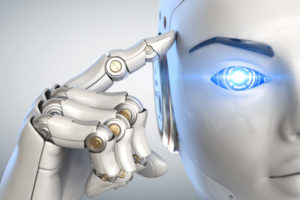
Is Your Business Ready for AI? Ask These 3 Questions

(Tatiana Shepeleva/Shutterstock)
Lately it seems that I can’t open Twitter or go to any news outlet without being bombarded by headlines about Artificial Intelligence (AI) and its impact on the global business landscape. Some people see AI as a great thing, while others worry that a robot will soon take their job. The truth is somewhere in-between; while it is unlikely to entirely eliminate many occupations over the next ten years, AI and machine learning will impact almost all industries, jobs and business to varying degrees.
Until recently, AI and machine learning initiatives were only on the strategic agendas of a few forward-thinking companies. Most organizations have chosen to take a “wait and see” attitude while those pioneers bore the risks of early adoption, but such a posture isn’t just shortsighted; it’s potentially dangerous. As money continues to pour into development and businesses from every sector start ramping up their efforts to integrate AI into their offerings, companies must invest immediately into their own AI solutions or risk falling behind. So how can you tell if your business processes are ripe for AI automation? Start by asking yourself the following questions:
Does your company rely heavily on data collection and processing?
Right now, across all occupations in the US economy, workers spend fully one-third of their time on data processing and collection. That is a mind blowing statistic, and this is one area where AI and machine learning can have a massive impact in terms of time and money saved.

(Timofeev Vladimir/Shutterstock)
Humans, by their nature, are prone to errors and biases when it comes to data analysis. Machines are now getting better at extracting insights from complex data sets than humans are and automating these processes can dramatically cut down on costly servicing mistakes, human-driven interpretation errors, and incorrect financial projections.
JPMorgan, for example, recently implemented a machine learning solution called COIN that completes in seconds work that used to take their lawyers thousands of hours to complete. By automating the process of interpreting commercial-loan agreements, COIN reduces errors in loan-servicing while sparing JP Morgan’s legal team more than 360,000 hours of work each year and saving the company millions of dollars.
Do your workers frequently have to make routine decisions or perform mundane tasks?
Automating routine decisions or tasks that fall under fairly rigid, established parameters is a perfect use case for AI. Mortgage brokers, for example, spend 90 percent of their time processing applications. By leveraging machine learning to automate the verification process, some experts estimate that proportion could be reduced to just 60 percent, freeing up huge amounts of time that could be far better spent focusing on the strategic tasks that cannot be automated like advising clients.

(Andrey_Popov/Shutterstock)
Radical advances in computing power, predictive analytics, machine learning and artificial intelligence have opened the door to a new generation of tools that can instantaneously comb through complex data sets to deliver recommended business actions where and when they are needed most. Rather than having to continually evaluate the same type of decision or perform the same analysis over and over, workers can be given access to systems that automatically present them with machine-accurate recommendations for the next business actions they should take. These systems dramatically improving performance, save time, and free up your expensive human talent to focus on strategic tasks.
Does your business model include predictable physical work?

(Photographee.eu/Shutterstock)
Automation of physical labor is nothing new. Since the dawn of time, mankind has sought tools that make them able to be more productive, more quickly with less effort. But while the image of a modern factory may be one where robots assemble everything, a recent McKinsey study found that almost one-fifth of the time Americans spend in the workplace involves operating machinery or performing physical labor in a predictable way. And if your business involves these processes, it’s time to automate!
The key to this is predictability. Unpredictable tasks, like firefighting or construction, will be extremely difficult to apply AI to. But tasks that occur on an assembly line or in a similar environment are perfect candidates. McKinsey estimates that 59 percent of all manufacturing activities could be automated, while a whopping 73 percent percent of the activities that food service workers perform have the potential for automation.
Preparing for the AI Takeover
Make no mistake: AI will transform the business landscape, with applications for every industry. Forrester Research expects “enterprise interest in, and use of, AI to increase as software vendors roll out AI platforms and build AI capabilities into applications,” as “enterprises that plan to invest in AI expect to improve customer experiences, improve products and services, and disrupt their industry with new business models.”
The time to evaluate your business’ potential for automation is now. These programs take time to implement successfully, and if you don’t start acting on these initiatives you put your business behind more agile and innovative competitors.
About the author: Roman Stanek is the CEO of GoodData, which he founded in 2007 with the mission to disrupt the business intelligence space and monetize big data. Prior to GoodData, Roman was founder and CEO of NetBeans, the leading Java development environment (acquired by Sun Microsystems in 1999) and Systinet, a leading SOA governance platform (acquired by Mercury Interactive, later Hewlett Packard, in 2006).
Related Items:
AI Makes Inroads into Enterprise Software
Machine Learning, Deep Learning, and AI: What’s the Difference?
Four Mandates to Turn Your Underutilized Data Into Revenue



























